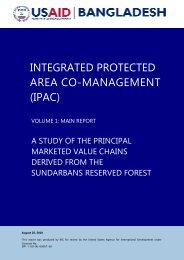Child Equity Atlas - BIDS
Child Equity Atlas - BIDS
Child Equity Atlas - BIDS
You also want an ePaper? Increase the reach of your titles
YUMPU automatically turns print PDFs into web optimized ePapers that Google loves.
<strong>Child</strong> <strong>Equity</strong> <strong>Atlas</strong><br />
5.4.1 In order to assess vulnerability and relative<br />
social deprivation status of households in different<br />
regions of the country, two additional indicators<br />
have been included which combine the indicators<br />
discussed before. The first is the combination of<br />
households without access to sanitary toilet and<br />
without electricity connection, and the second<br />
is households with access to both sanitary toilet<br />
and electricity. This combined household social<br />
deprivation measure shows that overall 43.3 per<br />
cent of households have access to both a sanitary<br />
toilet and electricity connection while 23.6<br />
per cent have access to neither sanitary toilets<br />
nor electricity. There are, however, significant<br />
variations between districts and upazilas with<br />
respect to access to these utilities (see Maps 5.8 to<br />
5.11). The relative status of districts with respect<br />
to these indicators is shown in Tables 5.5 and 5.6,<br />
depicting samples of best and worst performing<br />
districts only.<br />
Table 5.5: Proportion of households having<br />
access to both sanitary toilet and electricity<br />
connection: Best and worst districts,<br />
Bangladesh 2011<br />
Srl. Best districts Worst districts<br />
District % District %<br />
1. Dhaka 91.7 Gaibandha 14.3<br />
2. Narayanganj 76.3 Thakurgaon 14.9<br />
3. Munshiganj 76.2 Kurigram 15.2<br />
4. Gazipur 72.9 Lalmonirhat 15.4<br />
5. Chittagong 66.4 Bandarban 16.4<br />
Bangladesh: 43.3%<br />
Table 5.6: Proportion of households having<br />
no access to sanitary toilet and electricity<br />
connection: Best and worst districts,<br />
Bangladesh 2011<br />
Srl. Best districts Worst districts<br />
District % District %<br />
1. Dhaka 1.2 Bandarban 61.6<br />
2. Narayanganj 2.9 Gaibandha 54.4<br />
3. Munshiganj 4.4 Thakurgaon 52.5<br />
4. Gazipur 7.5 Sunamganj 52.1<br />
5. Comilla 8.5 Khagrachhari 50.8<br />
Bangladesh: 23.6%<br />
5.4.2 The performance of Bangladesh in some<br />
of these indicators on utilities and household<br />
facilities in this chapter should be viewed from<br />
many perspectives. While successive Governments<br />
continue to prioritize infrastructural development<br />
plus social investments, social movements, UN<br />
Agencies, donors, civil society and communities have<br />
made meaningful contributions in promoting the use<br />
of toilets, and reduced open defecation remarkably.<br />
According to WHO/UNICEF JMP (2012 22 ), 56 per<br />
cent of the population of Bangladesh has access<br />
to improved sanitation facilities, with remarkable<br />
reduction in open defecation to four per cent–<br />
successes attributable to multiple partnerships,<br />
Government leadership and community ownership<br />
of social development, including children engaged<br />
in whistle blowing and other aspects of Community<br />
Led Total Sanitation (CLTS). This chapter of the <strong>Equity</strong><br />
<strong>Atlas</strong> points the way forward to the pockets of<br />
persisting locations where further work is required<br />
in Bangladesh, to ensure equity in the pursuit of<br />
socioeconomic rights of children and women.<br />
22<br />
WHO/UNICEF 2012, Progress on Drinking Water and<br />
Sanitation: 2012 Update.http://www.unicef.org/media/files/<br />
JMPreport2012.pdf<br />
Photo : Ibrahim Khan Moni<br />
74














